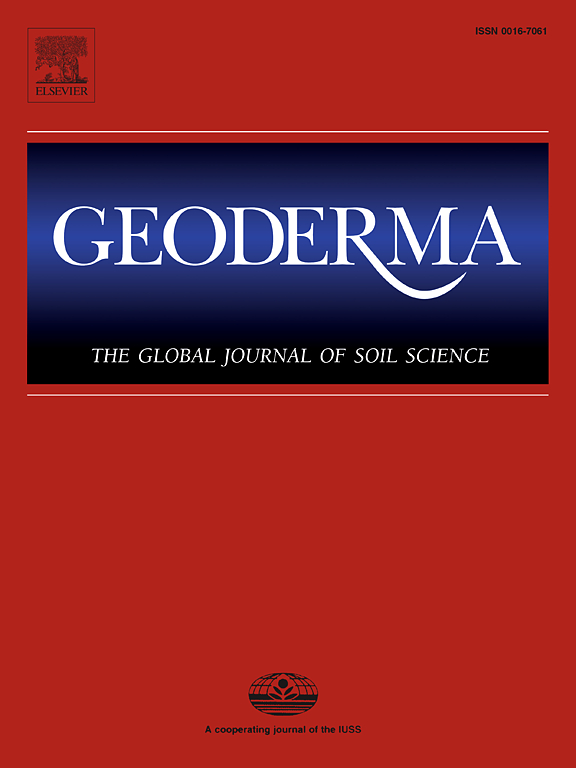Permafrost thawing by soil transplantation alters the functional genetic potential of the alpine permafrost microbiome
IF 5.6
1区 农林科学
Q1 SOIL SCIENCE
引用次数: 0
Abstract
Global warming has led to permafrost thawing in mid-latitude alpine regions, resulting in greater availability of carbon (C) and nutrients in soils. However, how these changes will impact the functional genetic potential of permafrost soil microbiomes, and subsequently, how they will influence the microbially mediated feedback of mountain soils under climate change remains unknown. To help answer this question, we conducted a permafrost thawing experiment on the north-facing slope near the summit of Muot da Barba Peider (2979 m above sea level) in the Swiss Alps. Specifically, we transplanted permafrost soils from a depth of 160 cm to the active-layer topsoils (0–18 cm) and incubated the soils in situ for three years. Using shotgun metagenomics, we found that transplantation significantly altered the gene structure of the permafrost microbiome, with changes occurring in the short term (< one year) and remaining stable over time. Transplanted soils exhibited an enhanced functional genetic potential, particularly for genes related to “Information storage and processing”, “Cellular processes and signaling” and “Metabolism” functions, which suggests increased cellular processes and metabolism. Carbohydrate-active enzymes involved in the degradation of both labile (such as starch) and recalcitrant (such as lignin) C substrates were enriched in transplanted soils, indicating an enhanced C-degradation potential. Nitrogen (N)-cycling genes related to the degradation and synthesis of N compounds, denitrification, assimilation and dissimilatory nitrate reduction were overrepresented in the transplanted soil, pointing to enhanced N assimilation and transformation potential. Our study elucidates how the permafrost microbiome may functionally respond to warming in the European Alps. This research complements observations from Tibetan and Arctic regions, improving our understanding of functional changes in thawing permafrost globally.
土壤移植的永久冻土融化改变了高山永久冻土微生物群的功能遗传潜力
全球变暖导致中纬度高山地区的永久冻土融化,导致土壤中碳(C)和养分的可用性增加。然而,这些变化将如何影响多年冻土土壤微生物群的功能遗传潜力,以及它们将如何影响气候变化下山地土壤微生物介导的反馈,目前尚不清楚。为了回答这个问题,我们在瑞士阿尔卑斯山的Muot da Barba Peider山顶(海拔2979米)附近的北坡上进行了永久冻土融化实验。具体而言,我们将160 cm深度的永久冻土土壤移植到0-18 cm的活动层表层土壤中,并在原位孵育3年。利用霰弹枪宏基因组学,我们发现移植显著改变了永久冻土微生物组的基因结构,这种变化发生在短期内(<;一年),并随着时间的推移保持稳定。移植土壤表现出增强的功能遗传潜力,特别是与“信息存储和处理”、“细胞过程和信号传导”和“代谢”功能相关的基因,这表明细胞过程和代谢增加。参与降解不稳定(如淀粉)和顽固性(如木质素)C底物的碳水化合物活性酶在移植土壤中富集,表明C降解潜力增强。移栽土壤中与氮化物降解合成、反硝化、同化和异化硝酸盐还原相关的氮循环基因较多,表明移栽土壤中氮素同化和转化潜力增强。我们的研究阐明了永久冻土微生物群如何在功能上对欧洲阿尔卑斯山的变暖做出反应。这项研究补充了西藏和北极地区的观测结果,提高了我们对全球永久冻土融化功能变化的理解。
本文章由计算机程序翻译,如有差异,请以英文原文为准。
求助全文
约1分钟内获得全文
求助全文
来源期刊

Geoderma
农林科学-土壤科学
CiteScore
11.80
自引率
6.60%
发文量
597
审稿时长
58 days
期刊介绍:
Geoderma - the global journal of soil science - welcomes authors, readers and soil research from all parts of the world, encourages worldwide soil studies, and embraces all aspects of soil science and its associated pedagogy. The journal particularly welcomes interdisciplinary work focusing on dynamic soil processes and functions across space and time.
 求助内容:
求助内容: 应助结果提醒方式:
应助结果提醒方式:


